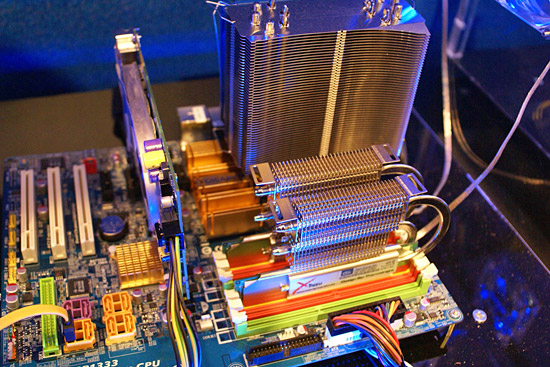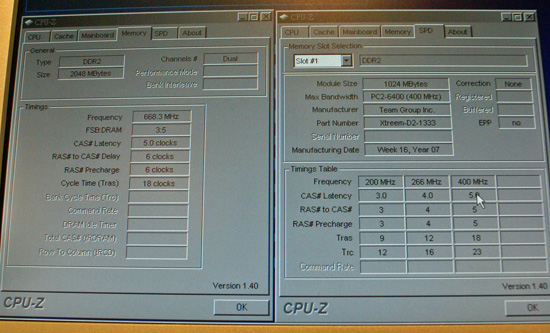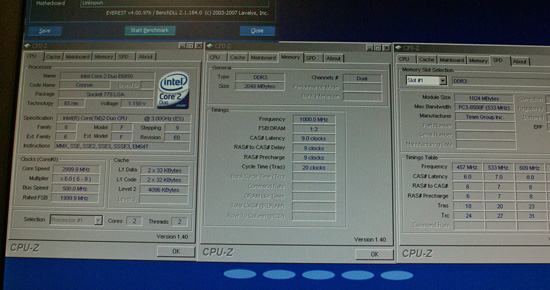Computex 2007: AMD's Barcelona and Other Products
by Gary Key on June 11, 2007 4:00 AM EST- Posted in
- Trade Shows
More Show Coverage
Besides our time spent with Barcelona, we decided to take the last day of Computex and take a last walk around the various halls looking for products or demonstrations that impressed us over the course of the last week in Taiwan. We've got some additional Computex coverage including a few interesting demonstrations behind closed doors, but first we need to catch a flight back home.
In terms of performance or excitement, we have to say that this year's show was again dominated by Intel based products. This is not to slight AMD, but the green team really did not bring its upcoming firepower to the show. This is not because they did not want to, but as we discussed already Barcelona/Agena as well as RD790 are just not mature enough yet to make the same kind of splash that Core 2 Duo did for Intel last year - and that early Penryn/X38 previews are doing to a lesser degree this year.
It would take several hundred pages of coverage to provide details on all of the products on display at this year's Computex. The vast majority of products we witnessed, touched, or tested have already been announced or even released so this year's show was a bit anti-climatic. Still, let's take a quick look at a few products that impressed us before we finish up our coverage and return home.
Team Group
Team Group is a well-known manufacturer of high performance memory and they had several demonstrations at their booth but we found these two to be extremely interesting.

The new Team Xtreme TXD3102-4M2000HC9 is a 1GB DDR3 module rated at 2000MHz. The modules are cooled by a custom Thermalright heatspreader and feature 9-9-9-20 timings at 1.90V~2.1V. This voltage is quite high for DDR3 memory but the modules feature Micron's new 8x128 ICs on a proprietary board design. While there has been plenty of screenshots showing DDR3 memory running above 2000MHz, those have generally been completed with a single module or custom 512MB modules in dual channel mode. In contrast, Team has managed to qualify this 2GB memory kit on the ASUS P5K3-Deluxe in dual channel mode up to 2100MHz.


Team Group also had their new TXDD1024M1333HC5, which is a 1GB DDR2 module rated at 1333MHz (on P35) with 5-6-6-18 timings at 2.35V~2.45V. This memory was installed on a Gigabyte GA-P35C-DS3R board with voltage set to 2.40, E6600 running at 6x400FSB, and the memory set at a 3:5 ratio with the timings listed above. While impressive for DDR2, we will have to wait to test the memory ourselves as chipset and memory strap latencies are fairly reduced on the Gigabyte board at this FSB setting.
Besides our time spent with Barcelona, we decided to take the last day of Computex and take a last walk around the various halls looking for products or demonstrations that impressed us over the course of the last week in Taiwan. We've got some additional Computex coverage including a few interesting demonstrations behind closed doors, but first we need to catch a flight back home.
In terms of performance or excitement, we have to say that this year's show was again dominated by Intel based products. This is not to slight AMD, but the green team really did not bring its upcoming firepower to the show. This is not because they did not want to, but as we discussed already Barcelona/Agena as well as RD790 are just not mature enough yet to make the same kind of splash that Core 2 Duo did for Intel last year - and that early Penryn/X38 previews are doing to a lesser degree this year.
It would take several hundred pages of coverage to provide details on all of the products on display at this year's Computex. The vast majority of products we witnessed, touched, or tested have already been announced or even released so this year's show was a bit anti-climatic. Still, let's take a quick look at a few products that impressed us before we finish up our coverage and return home.
Team Group
Team Group is a well-known manufacturer of high performance memory and they had several demonstrations at their booth but we found these two to be extremely interesting.

 |
| Click to enlarge |
The new Team Xtreme TXD3102-4M2000HC9 is a 1GB DDR3 module rated at 2000MHz. The modules are cooled by a custom Thermalright heatspreader and feature 9-9-9-20 timings at 1.90V~2.1V. This voltage is quite high for DDR3 memory but the modules feature Micron's new 8x128 ICs on a proprietary board design. While there has been plenty of screenshots showing DDR3 memory running above 2000MHz, those have generally been completed with a single module or custom 512MB modules in dual channel mode. In contrast, Team has managed to qualify this 2GB memory kit on the ASUS P5K3-Deluxe in dual channel mode up to 2100MHz.


Team Group also had their new TXDD1024M1333HC5, which is a 1GB DDR2 module rated at 1333MHz (on P35) with 5-6-6-18 timings at 2.35V~2.45V. This memory was installed on a Gigabyte GA-P35C-DS3R board with voltage set to 2.40, E6600 running at 6x400FSB, and the memory set at a 3:5 ratio with the timings listed above. While impressive for DDR2, we will have to wait to test the memory ourselves as chipset and memory strap latencies are fairly reduced on the Gigabyte board at this FSB setting.










64 Comments
View All Comments
MrEMan - Monday, June 11, 2007 - link
So, can someone explain to me what exactly AMD has gotten from its (paid) collaboration with IBM?It seems that once again IBM is unable to deliver on converting from lab design to actual production implementation.
defter - Monday, June 11, 2007 - link
I recall that AMD has licensed some process technology from IBM (including SOI).
??? Barcelona is AMD's design, it has nothing to do with IBM.
MrEMan - Monday, June 11, 2007 - link
Yes, Barcelona is strictly AMD's design, but are the problems being encountered due to the design, or the manufacturing of the new processors?It seems to me that it is more a manufacturing problem, because the current Athlons and Opterons haven't had any great performance enhancements/clock speed increases over the last few years.
TA152H - Monday, June 11, 2007 - link
Neither have Intel products. The fastest product they released was 3.8 GHz, and that was two or three years ago?Neosis - Tuesday, June 12, 2007 - link
Are you comparing a netburst based CPU with these ones?Do you have any idea about Integer Pipelines and Cache Latency?
defter - Monday, June 11, 2007 - link
Sub 2GHz speeds and motherboard issues cannot have anything to do with manufacturing issues.Even though 65nm K8s have very low clockspeeds, they are capable of reaching 2.6GHz@65W TDP (2 cores), thus hypothetical K8 based quad core would reach at least 2.6GHz@130W TDP. Since Barcelonas clockspeed is currently limited to 1.6-1.8GHz there must be significant issues with the design itself.
archcommus - Monday, June 11, 2007 - link
Let's face it, AMD has no hopes until at least early-mid next year, and that's assuming things DO improve significantly. Maybe they can keep themselves afloat with mediocre video, notebook, and low-power chip sales until then. Who knows what they've been doing there for the past four years since the original A64 launch. I know they had a cancelled project, but that still doesn't explain this kind of delay/lack of progress over that much time.But in the end, you can't win them all. AMD was king a couple years back, and now they're losing. They won't go out of business, and maybe they'll be a completely different company with their first 45 nm/next gen products.
In the meantime, I guess I'm betting on a cheap C2Q upgrade sometime in the next year.
nicolasb - Monday, June 11, 2007 - link
There are number of references to "RD600" in this article that should probably read "R600".Gary Key - Monday, June 11, 2007 - link
Sorry about that, corrected, it was a long flight home yesterday. ;-)clairvoyant129 - Monday, June 11, 2007 - link
Not surprising, scaling is terrible... by the time AMD rolls out 2.6GHz, forget Penryn, Intel will have Nehalem out.